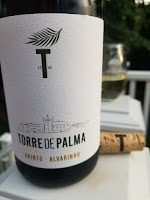 The climate is hot and dry with both a Continental and Mediterranean climate with winters exceptionally cold whereas spring and summer are dry and hot. The region experiences high levels of sunshine in the growing season -- over 3,000 hours annually. Wine-searcher.com also shares that the "Alentejo is broadly flat with hilly areas dotted across its zone. Major mountainous or hilly regions across the area include the Serra de São Mamede (1025m) on the border with Spain at the very northeastern end of the area, and the Serra de Portel (421m) and the Serra d’Ossa (649m), both in the central east".Portugal has one of the most expansive number of native grape varieties at close to 250, which is the highest density of native grapes per square mile of any country in the world. These grapes are also reflected in Alentejo with the native Antão Vaz, Arinto, and Alfrocheiro joining the international varieties Aragonez (Tempranillo) and Alicante Bouschet as major players.
The climate is hot and dry with both a Continental and Mediterranean climate with winters exceptionally cold whereas spring and summer are dry and hot. The region experiences high levels of sunshine in the growing season -- over 3,000 hours annually. Wine-searcher.com also shares that the "Alentejo is broadly flat with hilly areas dotted across its zone. Major mountainous or hilly regions across the area include the Serra de São Mamede (1025m) on the border with Spain at the very northeastern end of the area, and the Serra de Portel (421m) and the Serra d’Ossa (649m), both in the central east".Portugal has one of the most expansive number of native grape varieties at close to 250, which is the highest density of native grapes per square mile of any country in the world. These grapes are also reflected in Alentejo with the native Antão Vaz, Arinto, and Alfrocheiro joining the international varieties Aragonez (Tempranillo) and Alicante Bouschet as major players. These Alentejo wine facts were stressed during a recent Masterclass presented by Master Sommelier Evan Goldstein titled The 'A's of Alentejo. During the presentation we sipped six wines, each representing an "A" fact about the region. The wines were part of a Master the World wine kit of small bottles.
Antão Vaz - The Grape
This is the most dominate white grape in Alentejo and most prevalent in the Vidigueira and Reguengos sub-regions. The berries are loosely clustered and thick skinned providing disease resistance and they are also able to cope with drought-like conditions. In general it can provide stone and tropical fruit notes, various nuts, minerality, and ripe citrus. These characteristics were prevalent in the Herdade de Malhadinha Nova Antão Vaz da Malhadinha Branco 2022 ($30) with tropical, tangly lemons, cashews, and racing minerality.
Altitude
Although Alentejo is predominately flat, there are areas of significant height that provides important micro-climate benefits. In the northern region of Portalegre, vines planted on on steep slopes at close to 2,500 feet in the Serra de São Mamede benefit from lower temperatures and higher levels of humidity, yielding fresh, elegant wines. This was evident in the Quinta da Fonte Souto Branco 2021 ($29), a blend of 75% Arinto and 25% Verdelho and aged in various oak treatments. The grapes were harvested from two vineyards located at 1,640 feet. The wine is excellent with a creamy, generous mouthfeel; stone fruits; and a lasting somewhat chewy and tannic finish.
Amphora/Talha
The Phoenicians introduced viticulture into Portugal 2,500 years ago as well as the use of clay pots in the winemaking process. These talhas de barro or amphorae hold up to 520 gallons of wine and can be as large as seven-feet in height, and weigh a ton. The clay pots are lined with Pez - a mix of pine resin and beeswax to make the clay impenetrable. Unlike the Georgian process, amphora in Alentejo are stored above ground and are moistened during the fermentation process to lower temperatures. During this segment we sampled the Jose Maria da Fonseca Jose de Sousa 2017 ($19), a blend of Grand Noir, Touriga Francesa, and Touriga Nacional. It is dry, jammy with cherry and plums and a jolting tannic structure that mellows as the wine settles in the glass.
Alentejano Blends
Red blends comprise a large percentage of Alentejo output and the Fitapreta Tinto 2021 ($27) was appointed as their representative. This wine was fermented using native yeasts an is a blend of four grape varieties featuring primarily Aragonez (Tempranillo) and Alicante Bouschet. Expect a dry wine with loads of dark plum flavors interspersed with earthy tones and a chewy-tannic finish.
Activism
In 2015, the Wines of Alentejo Sustainability Program (WASP) was created to identify and certify sustainable farming and winemaking practices. Today the certification includes 171 criteria which 651 members have met. These criteria include reducing pesticides and other chemicals, conserving water, soil management, and worker wellbeing. Casa Agricole Alexandre Relvas is WASP certified and dedicates a portion of its land to preserve local endangered plant species. We sipped a wine from their first label, the Herdade de São Miguel Colheita Seleccionada Tinto 2018 ($16). This another four grape red blend dominated by Alicante Bouschet and Touriga Nacional and is fresh and vibrant with a bright cherry nose, fresh fruit, and a long acidic finish.
Alicante Bouschet
Although not indigenous to Portugal it has found a home accounting for 2% of all Portuguese plantings and ranking #8 for all reds. The grape thrives in Alentejo, particularly in Vidigueira and Reguengos, and is the second most planted red grape after Aragonez. It produced dense wines with dark fruit, pepper, smoke, and abundant tartness and astringency. The Herdade de Rocim Alicante Bouschet 2021 ($23) is drinkable now but will benefit with more age as the licorice and tart, astringent, and tannic characters mellow into juicy dark fruit.




